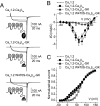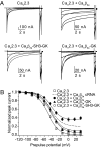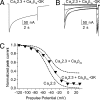The guanylate kinase domain of the beta-subunit of voltage-gated calcium channels suffices to modulate gating
- PMID: 18776052
- PMCID: PMC2544601
- DOI: 10.1073/pnas.0806558105
The guanylate kinase domain of the beta-subunit of voltage-gated calcium channels suffices to modulate gating
Abstract
Inactivation of voltage-gated calcium channels is crucial for the spatiotemporal coordination of calcium signals and prevention of toxic calcium buildup. Only one member of the highly conserved family of calcium channel beta-subunits--Ca(V)beta--inhibits inactivation. This unique property has been attributed to short variable regions of the protein; however, here we report that this inhibition actually is conferred by a conserved guanylate kinase (GK) domain and, moreover, that this domain alone recapitulates Ca(V)beta-mediated modulation of channel activation. We expressed and refolded the GK domain of Ca(V)beta(2a), the unique variant that inhibits inactivation, and of Ca(V)beta(1b), an isoform that facilitates it. The refolded domains of both Ca(V)beta variants were found to inhibit inactivation of Ca(V)2.3 channels expressed in Xenopus laevis oocytes. These findings suggest that the GK domain endows calcium channels with a brake restraining voltage-dependent inactivation, and thus facilitation of inactivation by full-length Ca(V)beta requires additional structural determinants to antagonize the GK effect. We found that Ca(V)beta can switch the inactivation phenotype conferred to Ca(V)2.3 from slow to fast after posttranslational modifications during channel biogenesis. Our findings provide a framework within which to understand the modulation of inactivation and a new functional map of Ca(V)beta in which the GK domain regulates channel gating and the other conserved domain (Src homology 3) may couple calcium channels to other signaling pathways.
Conflict of interest statement
The authors declare no conflict of interest.
Figures







Similar articles
-
The ß subunit of voltage-gated Ca2+ channels.Physiol Rev. 2010 Oct;90(4):1461-506. doi: 10.1152/physrev.00057.2009. Physiol Rev. 2010. PMID: 20959621 Free PMC article. Review.
-
A CaVbeta SH3/guanylate kinase domain interaction regulates multiple properties of voltage-gated Ca2+ channels.J Gen Physiol. 2005 Oct;126(4):365-77. doi: 10.1085/jgp.200509354. J Gen Physiol. 2005. PMID: 16186563 Free PMC article.
-
The HOOK-domain between the SH3 and the GK domains of Cavbeta subunits contains key determinants controlling calcium channel inactivation.Channels (Austin). 2007 Mar-Apr;1(2):92-101. doi: 10.4161/chan.4145. Epub 2007 Mar 15. Channels (Austin). 2007. PMID: 18690022
-
Origin of the voltage dependence of G-protein regulation of P/Q-type Ca2+ channels.J Neurosci. 2008 Dec 24;28(52):14176-88. doi: 10.1523/JNEUROSCI.1350-08.2008. J Neurosci. 2008. PMID: 19109500 Free PMC article.
-
Multiplicity of protein interactions and functions of the voltage-gated calcium channel beta-subunit.Cell Calcium. 2007 Oct-Nov;42(4-5):389-96. doi: 10.1016/j.ceca.2007.05.009. Epub 2007 Jul 13. Cell Calcium. 2007. PMID: 17629941 Review.
Cited by
-
The ß subunit of voltage-gated Ca2+ channels.Physiol Rev. 2010 Oct;90(4):1461-506. doi: 10.1152/physrev.00057.2009. Physiol Rev. 2010. PMID: 20959621 Free PMC article. Review.
-
Gαi2- and Gαi3-specific regulation of voltage-dependent L-type calcium channels in cardiomyocytes.PLoS One. 2011;6(9):e24979. doi: 10.1371/journal.pone.0024979. Epub 2011 Sep 26. PLoS One. 2011. PMID: 21966394 Free PMC article.
-
Direct interaction of CaVβ with actin up-regulates L-type calcium currents in HL-1 cardiomyocytes.J Biol Chem. 2015 Feb 20;290(8):4561-4572. doi: 10.1074/jbc.M114.573956. Epub 2014 Dec 22. J Biol Chem. 2015. PMID: 25533460 Free PMC article.
-
Ahnak1 modulates L-type Ca(2+) channel inactivation of rodent cardiomyocytes.Pflugers Arch. 2010 Sep;460(4):719-30. doi: 10.1007/s00424-010-0853-x. Epub 2010 Jul 7. Pflugers Arch. 2010. PMID: 20607281
-
Enzyme closure and nucleotide binding structurally lock guanylate kinase.Biophys J. 2011 Sep 21;101(6):1440-9. doi: 10.1016/j.bpj.2011.07.048. Epub 2011 Sep 20. Biophys J. 2011. PMID: 21943425 Free PMC article.
References
-
- Catterall WA. Structure and regulation of voltage-gated Ca2+ channels. Annu Rev Cell Dev Biol. 2000;16:521–555. - PubMed
-
- Pragnell M, et al. Calcium channel β-subunit binds to a conserved motif in the I-II cytoplasmic linker of the α1-subunit. Nature. 1994;368:67–70. - PubMed
-
- Harry JB, Kobrinsky E, Abernethy DR, Soldatov NM. New short splice variants of the human cardiac Cavbeta2 subunit: Redefining the major functional motifs implemented in modulation of the Cav1.2 channel. J Biol Chem. 2004;279:46367–46372. - PubMed
-
- Opatowsky Y, Chen CC, Campbell KP, Hirsch JA. Structural analysis of the voltage-dependent calcium channel beta subunit functional core and its complex with the alpha 1 interaction domain. Neuron. 2004;42:387–399. - PubMed
-
- Chen YH, et al. Structural basis of the alpha1-beta subunit interaction of voltage-gated Ca2+ channels. Nature. 2004;429:675–680. - PubMed
Publication types
MeSH terms
Substances
LinkOut - more resources
Full Text Sources
Molecular Biology Databases
Miscellaneous

